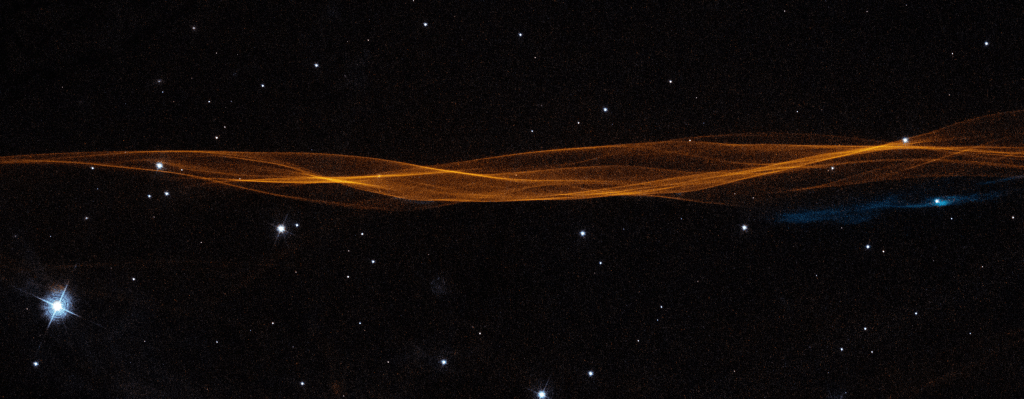Hubble data shows expansion of supernova remnant

Astronomers have created a four-second long movie using Hubble images collected over twenty years that shows the expansion of one filament in the Cygnus Loop supernova remnant, the explosion of which is thought to have occurred 20,000 years ago.
The picture above is one frame of that movie. The filament is estimated to be two light years in length.
By analyzing the shock’s location, astronomers found that the shock hasn’t slowed down at all in the last 20 years, and is speeding into interstellar space at over half a million miles per hour – fast enough to travel from Earth to the Moon in less than half an hour. While this seems incredibly fast, it’s actually on the slow end for the speed of a supernova shock wave.
Two versions of the movie are at the link, with the longer providing excellent context.
On Christmas Eve 1968 three Americans became the first humans to visit another world. What they did to celebrate was unexpected and profound, and will be remembered throughout all human history. Genesis: the Story of Apollo 8, Robert Zimmerman's classic history of humanity's first journey to another world, tells that story, and it is now available as both an ebook and an audiobook, both with a foreword by Valerie Anders and a new introduction by Robert Zimmerman.
The print edition can be purchased at Amazon or from any other book seller. If you want an autographed copy the price is $60 for the hardback and $45 for the paperback, plus $8 shipping for each. Go here for purchasing details. The ebook is available everywhere for $5.99 (before discount) at amazon, or direct from my ebook publisher, ebookit. If you buy it from ebookit you don't support the big tech companies and the author gets a bigger cut much sooner.
The audiobook is also available at all these vendors, and is also free with a 30-day trial membership to Audible.
"Not simply about one mission, [Genesis] is also the history of America's quest for the moon... Zimmerman has done a masterful job of tying disparate events together into a solid account of one of America's greatest human triumphs."--San Antonio Express-News

Astronomers have created a four-second long movie using Hubble images collected over twenty years that shows the expansion of one filament in the Cygnus Loop supernova remnant, the explosion of which is thought to have occurred 20,000 years ago.
The picture above is one frame of that movie. The filament is estimated to be two light years in length.
By analyzing the shock’s location, astronomers found that the shock hasn’t slowed down at all in the last 20 years, and is speeding into interstellar space at over half a million miles per hour – fast enough to travel from Earth to the Moon in less than half an hour. While this seems incredibly fast, it’s actually on the slow end for the speed of a supernova shock wave.
Two versions of the movie are at the link, with the longer providing excellent context.
On Christmas Eve 1968 three Americans became the first humans to visit another world. What they did to celebrate was unexpected and profound, and will be remembered throughout all human history. Genesis: the Story of Apollo 8, Robert Zimmerman's classic history of humanity's first journey to another world, tells that story, and it is now available as both an ebook and an audiobook, both with a foreword by Valerie Anders and a new introduction by Robert Zimmerman.
The print edition can be purchased at Amazon or from any other book seller. If you want an autographed copy the price is $60 for the hardback and $45 for the paperback, plus $8 shipping for each. Go here for purchasing details. The ebook is available everywhere for $5.99 (before discount) at amazon, or direct from my ebook publisher, ebookit. If you buy it from ebookit you don't support the big tech companies and the author gets a bigger cut much sooner.
The audiobook is also available at all these vendors, and is also free with a 30-day trial membership to Audible.
"Not simply about one mission, [Genesis] is also the history of America's quest for the moon... Zimmerman has done a masterful job of tying disparate events together into a solid account of one of America's greatest human triumphs."--San Antonio Express-News


That answer a long-standing question of mine: Can we actually see anything _changing_ out there or is all too far away and slow (in human terms)?
markedup2: Your question was actually answered years ago by Hubble. In looking at many different planetary nebula, supernovae remnants, and clouds it has detected motion and change and made many movies of that change.
Do a search on BtB for “Eta Carina” and “Crab Nebula” for two of the more famous examples of this work.